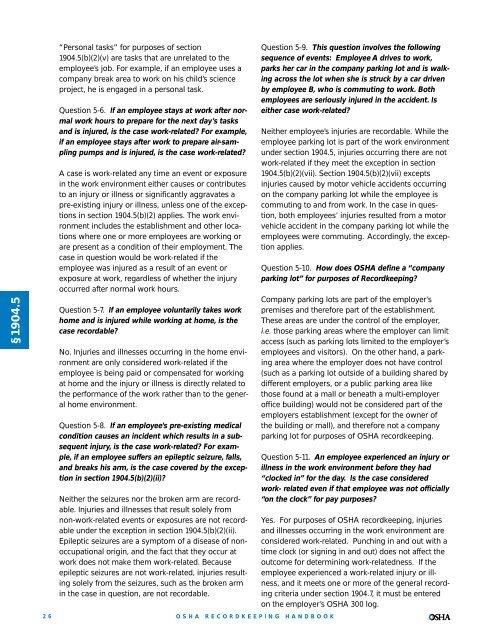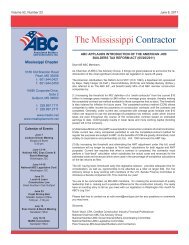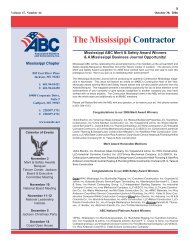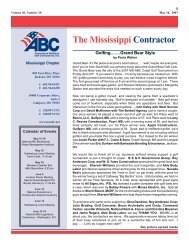OSHA Recordkeeping Handbook - Msabc.net
OSHA Recordkeeping Handbook - Msabc.net
OSHA Recordkeeping Handbook - Msabc.net
You also want an ePaper? Increase the reach of your titles
YUMPU automatically turns print PDFs into web optimized ePapers that Google loves.
§1904.526“Personal tasks” for purposes of section1904.5(b)(2)(v) are tasks that are unrelated to theemployee’s job. For example, if an employee uses acompany break area to work on his child’s scienceproject, he is engaged in a personal task.Question 5-6. If an employee stays at work after normalwork hours to prepare for the next day’s tasksand is injured, is the case work-related? For example,if an employee stays after work to prepare air-samplingpumps and is injured, is the case work-related?A case is work-related any time an event or exposurein the work environment either causes or contributesto an injury or illness or significantly aggravates apre-existing injury or illness, unless one of the exceptionsin section 1904.5(b)(2) applies. The work environmentincludes the establishment and other locationswhere one or more employees are working orare present as a condition of their employment. Thecase in question would be work-related if theemployee was injured as a result of an event orexposure at work, regardless of whether the injuryoccurred after normal work hours.Question 5-7. If an employee voluntarily takes workhome and is injured while working at home, is thecase recordable?No. Injuries and illnesses occurring in the home environmentare only considered work-related if theemployee is being paid or compensated for workingat home and the injury or illness is directly related tothe performance of the work rather than to the generalhome environment.Question 5-8. If an employee’s pre-existing medicalcondition causes an incident which results in a subsequentinjury, is the case work-related? For example,if an employee suffers an epileptic seizure, falls,and breaks his arm, is the case covered by the exceptionin section 1904.5(b)(2)(ii)?Neither the seizures nor the broken arm are recordable.Injuries and illnesses that result solely fromnon-work-related events or exposures are not recordableunder the exception in section 1904.5(b)(2)(ii).Epileptic seizures are a symptom of a disease of nonoccupationalorigin, and the fact that they occur atwork does not make them work-related. Becauseepileptic seizures are not work-related, injuries resultingsolely from the seizures, such as the broken armin the case in question, are not recordable.<strong>OSHA</strong> RECORDKEEPINGQuestion 5-9. This question involves the followingsequence of events: Employee A drives to work,parks her car in the company parking lot and is walkingacross the lot when she is struck by a car drivenby employee B, who is commuting to work. Bothemployees are seriously injured in the accident. Iseither case work-related?Neither employee’s injuries are recordable. While theemployee parking lot is part of the work environmentunder section 1904.5, injuries occurring there are notwork-related if they meet the exception in section1904.5(b)(2)(vii). Section 1904.5(b)(2)(vii) exceptsinjuries caused by motor vehicle accidents occurringon the company parking lot while the employee iscommuting to and from work. In the case in question,both employees’ injuries resulted from a motorvehicle accident in the company parking lot while theemployees were commuting. Accordingly, the exceptionapplies.Question 5-10. How does <strong>OSHA</strong> define a “companyparking lot” for purposes of <strong>Recordkeeping</strong>?Company parking lots are part of the employer’spremises and therefore part of the establishment.These areas are under the control of the employer,i.e. those parking areas where the employer can limitaccess (such as parking lots limited to the employer’semployees and visitors). On the other hand, a parkingarea where the employer does not have control(such as a parking lot outside of a building shared bydifferent employers, or a public parking area likethose found at a mall or beneath a multi-employeroffice building) would not be considered part of theemployers establishment (except for the owner ofthe building or mall), and therefore not a companyparking lot for purposes of <strong>OSHA</strong> recordkeeping.Question 5-11. An employee experienced an injury orillness in the work environment before they had“clocked in” for the day. Is the case consideredwork- related even if that employee was not officially“on the clock” for pay purposes?Yes. For purposes of <strong>OSHA</strong> recordkeeping, injuriesand illnesses occurring in the work environment areconsidered work-related. Punching in and out with atime clock (or signing in and out) does not affect theoutcome for determining work-relatedness. If theemployee experienced a work-related injury or illness,and it meets one or more of the general recordingcriteria under section 1904.7, it must be enteredon the employer’s <strong>OSHA</strong> 300 log.HANDBOOK







